
Miao Xiaochun
#Artiste
1964 Miao Xiaochun Born in Wuxi Jiangsu
1982 - 1986 Studied at the Nangjing University
1986 - 1989 Central Academy of Fine Arts, Beijing
1995 - 1999 Studied at the Kunsthochschule Kassel, Germany
Presently teaches Photography and Digital Media at the Central Academy of Fine Arts, Beijing, China.
Selected Exhibitions
2006 "Mahjong - Chinesische Gegenwartskunst aus der Sammlung Sigg", Hamburger Kunsthalle, Hamburg, Germany
2006 "MoCA Envisagel - Entry Gate: Chinese Aesthetics of Heterogeneity", MoCA Shanghai, Shanghai, China
2006 "City skin-images of the contemporary Metropolis", Shenzhen Art Museum, Shenzhen, China
2006 «Between Past and Future - New Photography and Video from China Haus der Kulturen der Welt, Berlin, Germany
2006 Walsh Gallery, Chicago, USA (solo)
2005 Guangzhou international Photo Biennale, Guangdong Art Museum, Gunagzhou, China
2005 The city in 360 degrees,Beijing new art projects,Dashanzi art district
2005 Chengdu Biennale 2005
2005 Making a new relationship - The Art Ethics,Dimensions Art Center
2005 Confluentes II,international artists in Ludwig Museum Koblenz,Germany
2005 «Between Past and Future-New Photography and Video from China »,Victoria and Albert Museum .London,UK
2005 «City of dreams»The Red Mansion Foundation, London,UK
2005 Art Forum Berlin 2005, Berlin, Germany
2005 "City skin-images of the contemporary metropolis", Gallery Tap Seac, Macao, China
2005 "Grounding Reality: New Generation of Chinese Contemporary art in the Seoul Art Center, South Korea
2005 Skin of City", Tashi Art Museum, Macao
2005 "Mahjong - Chinesische Gegenwartskunst aus der Sammlung Sigg ", Kunstmuseum Bern, Switzerland
2005 "Between Past and Future: New Photography and Video from China", Seattle Art Museum, Seattle
2005 "Between Past and Future: New Photography and Video from China", Museum of Conremporary Art Chicago, Chicago, USA
2005 "Between Past and Future: New Photography and Video from China", The David and Alfred Smart Museum of Art, Chicago, USA
2005 "Urban legend", 798 space, Beijing, China
2005 "Harvest-chinese Photography Exposition", Art Scene Warehouse Shanghai, China
2005 Art Toronto 2005, Toronto, Canada
2005 Pinyao International Photo Fair 2005
2004 "Le Printemps de Chine", CRAC ALSAC, Altkirch, France
2004 "LiuHaiSu", Art Museum Shanghai, China
2004 "PingYao in Paris", MK2, Paris, France
2004 Museum of contemporary Art, TaiBei, Taiwan
2004 "Miao Xiaochun and Rivka Rinn", White Squre 797, Art Space, Beijing
2004 Between Past and Future: New Photography and Video from China", ICP International Center of Photography, New York, USA
2004 "A Visitor from the Past"Epson Photogallery Shanghai-Beijing (solo)
2003 "New Works" Museum of the Central Academy of Fine Arts, Beijing, China (solo)
2003 "me & more", Kunstmuseum Luzern, Switzerland
2003 "Asia Art Now", Seoul, Korea
2003 "Left Hand and Right Hand", 798 Art District, Sanhe Art Center, Beijing
2003 CAFA, Art museum, Beijing
2002 Shanghai Biennale 2002
2002 "China - Tradition und Moderne", Ludwig Galerie Schloss Oberhausen, D
2002 "Media City Seoul 2002" The 2nd Seoul international media art biennale, Seoul, Korea
2002 "Chinese Contemporary Art" Museum of Contemporary Art, Zagreb
2002 "Fantasia" East Modern Art Center, Beijing, China
2002 "Under Construction" Tokyo Opera City Art Gallery
2002 "Linger" Galerie Urs Meile, Lucerne, Switzerland (solo)
2001 "From East to West and back to East" Museum of the Central Academy of Fine Arts, Beijing, China (solo)
1994 Beijing Art Museum, China (solo)
1994 Shanghai Art Museum, China (solo)
1992 National Museum of Chinese history, Beijing, China (solo)
1991 Beijing Art Museum, China (solo)
- Livre
Miao Xiaochun: 2009-1999
 Alexander Ochs (Sous la direction de)...
Alexander Ochs (Sous la direction de)... - Exposition
NOREVOVER, «De la réalité et au de-là», à la On-Gallery
 Exposition photographie contemporaine et vidéo Chine-Europe
Norev-Over propose par l’exposition d’artistes européens et chinois d’interroger les nouvelles perceptions du réel en rapport aux transformations des techniques de repré- sentations. La technologie 3D, le montage numérique, ou la mise en scène du réel en relation avec ces évolutions technologiques nous amènent à concevoir une réalité nouvelle. L’exposition vise à retourner du côté des usages des outils de reproduction du réel et à voir comment se négocie une transformation de la représentation de l’être par l’usage des nouvelles technologies créant un monde virtuel empreint de réalité.
Norev-Over : Pas de rêve au de-là du réel, mais une réalité ps...
Exposition photographie contemporaine et vidéo Chine-Europe
Norev-Over propose par l’exposition d’artistes européens et chinois d’interroger les nouvelles perceptions du réel en rapport aux transformations des techniques de repré- sentations. La technologie 3D, le montage numérique, ou la mise en scène du réel en relation avec ces évolutions technologiques nous amènent à concevoir une réalité nouvelle. L’exposition vise à retourner du côté des usages des outils de reproduction du réel et à voir comment se négocie une transformation de la représentation de l’être par l’usage des nouvelles technologies créant un monde virtuel empreint de réalité.
Norev-Over : Pas de rêve au de-là du réel, mais une réalité ps... - Exposition
Miao Xiaochun - Beijing index
 After working with digital art, Miao Xiaochun returns to photography with his series 'Beijing Index'. The artist drafted longitudes and latitudes on a satellite image of Beijing, and as a result the crossing points formed the basis for the design study after which 639 photographs were taken.
Miao Xiaochun uses a round shot camera by Seitz that enables him to take extremely expanded photographs in a 360 degrees angle. The mechanic of the camera allows him to renounce from any individual choice of motif - apart from his personal ideas and favoured themes - and creates a diverse portrait of the rapidly changing Beijing.
Due to the randomness of the fixed design study the artist does not differentiate between indoor and outdoor spaces and thereby depicts the reality of 'public spaces' as much as the intimacy of private...
After working with digital art, Miao Xiaochun returns to photography with his series 'Beijing Index'. The artist drafted longitudes and latitudes on a satellite image of Beijing, and as a result the crossing points formed the basis for the design study after which 639 photographs were taken.
Miao Xiaochun uses a round shot camera by Seitz that enables him to take extremely expanded photographs in a 360 degrees angle. The mechanic of the camera allows him to renounce from any individual choice of motif - apart from his personal ideas and favoured themes - and creates a diverse portrait of the rapidly changing Beijing.
Due to the randomness of the fixed design study the artist does not differentiate between indoor and outdoor spaces and thereby depicts the reality of 'public spaces' as much as the intimacy of private... - Exposition
MIAO XIAOCHUN : INDEX
 'We all give priority to the 'objectivity' of photographs; however, everyone makes a subjective choice prior to shooting. We choose the theme, the location, the time of shooting, the aperture and the shutter speed; we decide on the people and objects entering the frame.
If we really don't know what to shoot, we can shoot first and select later or we can ask someone else to choose for us. After selecting a few, we can pigeonhole the others and wait for later generations to choose again. Think about how we handle pictures left by earlier generations, some have artistic others have documentary value and it is wrong to destroy any of them (although the remains are never enough to restore the long gone past.)
Thus, the question is still how we make decisions when shooting, but maybe we do not need to choose at all. There ar...
'We all give priority to the 'objectivity' of photographs; however, everyone makes a subjective choice prior to shooting. We choose the theme, the location, the time of shooting, the aperture and the shutter speed; we decide on the people and objects entering the frame.
If we really don't know what to shoot, we can shoot first and select later or we can ask someone else to choose for us. After selecting a few, we can pigeonhole the others and wait for later generations to choose again. Think about how we handle pictures left by earlier generations, some have artistic others have documentary value and it is wrong to destroy any of them (although the remains are never enough to restore the long gone past.)
Thus, the question is still how we make decisions when shooting, but maybe we do not need to choose at all. There ar... - Exposition
MIAO XIAOCHUN - INDEX
 Beijing Index
We all give priority to the objectivity of photographs; however, everyone has to make a subjective choice when he shoots photographs. From the point of view of a photographer we have to choose the theme, the location and the time of shooting; we have to choose the people and objects entering the frame; we also have to choose the aperture and the shutter speed, etc. But how do we handle pictures left by earlier generations? It seems like we kept all of them: some have artistic values and some have documentary values; so it is wrong to destroy any of them. Thus, the question is still how we make choices while shooting. Maybe we do not need to choose at all. There is a reason for choosing and not choosing: the former is more subjective and latter more objective; the former is more expressive and latte...
Beijing Index
We all give priority to the objectivity of photographs; however, everyone has to make a subjective choice when he shoots photographs. From the point of view of a photographer we have to choose the theme, the location and the time of shooting; we have to choose the people and objects entering the frame; we also have to choose the aperture and the shutter speed, etc. But how do we handle pictures left by earlier generations? It seems like we kept all of them: some have artistic values and some have documentary values; so it is wrong to destroy any of them. Thus, the question is still how we make choices while shooting. Maybe we do not need to choose at all. There is a reason for choosing and not choosing: the former is more subjective and latter more objective; the former is more expressive and latte... - Exposition
MIAO XIAOCHUN: H2O
 Miao Xiaochun has come back, down to earth. Back from the spheres of heaven, with figures floating in the detached and airy space that he so closely explored in his last large picture-series "The Last Judgement". And yet, it is not so much the firm and solid ground of earth that the Chinese photo-artist is interested in. He rather turns his attention towards an element which, at first sight, seems about as hard to grasp as the atmospheric range of the sky: water. However, the framework that he chose for his explorations (investigations) consistently remains the same: the array of Western art-history. He furthers his forays through the world of art and painting. And he leaves many enthralling hints for the observer, allowing him to follow.
Masterly in his use of digital visual media, Miao Xiaochun time and again lets u...
Miao Xiaochun has come back, down to earth. Back from the spheres of heaven, with figures floating in the detached and airy space that he so closely explored in his last large picture-series "The Last Judgement". And yet, it is not so much the firm and solid ground of earth that the Chinese photo-artist is interested in. He rather turns his attention towards an element which, at first sight, seems about as hard to grasp as the atmospheric range of the sky: water. However, the framework that he chose for his explorations (investigations) consistently remains the same: the array of Western art-history. He furthers his forays through the world of art and painting. And he leaves many enthralling hints for the observer, allowing him to follow.
Masterly in his use of digital visual media, Miao Xiaochun time and again lets u... - Exposition
Miao Xiaochun The Last Judgment in Cyberspace
 Wu Hung curates Beijing-based Miao Xiaochun's newest photography and video, which reexamine Michelangelo's "Last Judgment" using digital technology.
Miao Xiaochun has generated a 3-D model of his body and substituted his image for each of the 400 figures in Michelangelo's painting. Using software to manipulate the model into different positions, he then integrated these 3-D figures into a virtual space based on Michelangelo's composition. He could then travel within the painting like a tourist, taking photos as he went along, from within the pictorial frame as well as from without. The artist worked with three assistants for six months to create these works.
Wu Hung writes, "What do the figures in Michelangelo's Last Judgement - not only Christ and the Virgin but also the angels, the saints, the Damned, and the B...
Wu Hung curates Beijing-based Miao Xiaochun's newest photography and video, which reexamine Michelangelo's "Last Judgment" using digital technology.
Miao Xiaochun has generated a 3-D model of his body and substituted his image for each of the 400 figures in Michelangelo's painting. Using software to manipulate the model into different positions, he then integrated these 3-D figures into a virtual space based on Michelangelo's composition. He could then travel within the painting like a tourist, taking photos as he went along, from within the pictorial frame as well as from without. The artist worked with three assistants for six months to create these works.
Wu Hung writes, "What do the figures in Michelangelo's Last Judgement - not only Christ and the Virgin but also the angels, the saints, the Damned, and the B...
Modifier l'image
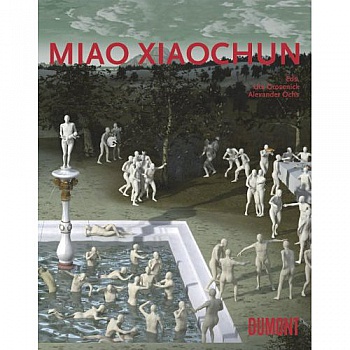 Alexander Ochs (Sous la direction de)...
Alexander Ochs (Sous la direction de)... Exposition photographie contemporaine et vidéo Chine-Europe
Norev-Over propose par l’exposition d’artistes européens et chinois d’interroger les nouvelles perceptions du réel en rapport aux transformations des techniques de repré- sentations. La technologie 3D, le montage numérique, ou la mise en scène du réel en relation avec ces évolutions technologiques nous amènent à concevoir une réalité nouvelle. L’exposition vise à retourner du côté des usages des outils de reproduction du réel et à voir comment se négocie une transformation de la représentation de l’être par l’usage des nouvelles technologies créant un monde virtuel empreint de réalité.
Norev-Over : Pas de rêve au de-là du réel, mais une réalité ps...
Exposition photographie contemporaine et vidéo Chine-Europe
Norev-Over propose par l’exposition d’artistes européens et chinois d’interroger les nouvelles perceptions du réel en rapport aux transformations des techniques de repré- sentations. La technologie 3D, le montage numérique, ou la mise en scène du réel en relation avec ces évolutions technologiques nous amènent à concevoir une réalité nouvelle. L’exposition vise à retourner du côté des usages des outils de reproduction du réel et à voir comment se négocie une transformation de la représentation de l’être par l’usage des nouvelles technologies créant un monde virtuel empreint de réalité.
Norev-Over : Pas de rêve au de-là du réel, mais une réalité ps...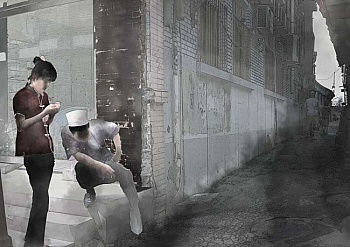 After working with digital art, Miao Xiaochun returns to photography with his series 'Beijing Index'. The artist drafted longitudes and latitudes on a satellite image of Beijing, and as a result the crossing points formed the basis for the design study after which 639 photographs were taken.
Miao Xiaochun uses a round shot camera by Seitz that enables him to take extremely expanded photographs in a 360 degrees angle. The mechanic of the camera allows him to renounce from any individual choice of motif - apart from his personal ideas and favoured themes - and creates a diverse portrait of the rapidly changing Beijing.
Due to the randomness of the fixed design study the artist does not differentiate between indoor and outdoor spaces and thereby depicts the reality of 'public spaces' as much as the intimacy of private...
After working with digital art, Miao Xiaochun returns to photography with his series 'Beijing Index'. The artist drafted longitudes and latitudes on a satellite image of Beijing, and as a result the crossing points formed the basis for the design study after which 639 photographs were taken.
Miao Xiaochun uses a round shot camera by Seitz that enables him to take extremely expanded photographs in a 360 degrees angle. The mechanic of the camera allows him to renounce from any individual choice of motif - apart from his personal ideas and favoured themes - and creates a diverse portrait of the rapidly changing Beijing.
Due to the randomness of the fixed design study the artist does not differentiate between indoor and outdoor spaces and thereby depicts the reality of 'public spaces' as much as the intimacy of private... 'We all give priority to the 'objectivity' of photographs; however, everyone makes a subjective choice prior to shooting. We choose the theme, the location, the time of shooting, the aperture and the shutter speed; we decide on the people and objects entering the frame.
If we really don't know what to shoot, we can shoot first and select later or we can ask someone else to choose for us. After selecting a few, we can pigeonhole the others and wait for later generations to choose again. Think about how we handle pictures left by earlier generations, some have artistic others have documentary value and it is wrong to destroy any of them (although the remains are never enough to restore the long gone past.)
Thus, the question is still how we make decisions when shooting, but maybe we do not need to choose at all. There ar...
'We all give priority to the 'objectivity' of photographs; however, everyone makes a subjective choice prior to shooting. We choose the theme, the location, the time of shooting, the aperture and the shutter speed; we decide on the people and objects entering the frame.
If we really don't know what to shoot, we can shoot first and select later or we can ask someone else to choose for us. After selecting a few, we can pigeonhole the others and wait for later generations to choose again. Think about how we handle pictures left by earlier generations, some have artistic others have documentary value and it is wrong to destroy any of them (although the remains are never enough to restore the long gone past.)
Thus, the question is still how we make decisions when shooting, but maybe we do not need to choose at all. There ar...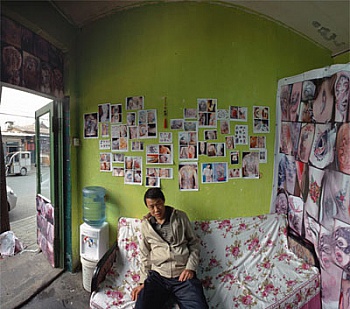 Beijing Index
We all give priority to the objectivity of photographs; however, everyone has to make a subjective choice when he shoots photographs. From the point of view of a photographer we have to choose the theme, the location and the time of shooting; we have to choose the people and objects entering the frame; we also have to choose the aperture and the shutter speed, etc. But how do we handle pictures left by earlier generations? It seems like we kept all of them: some have artistic values and some have documentary values; so it is wrong to destroy any of them. Thus, the question is still how we make choices while shooting. Maybe we do not need to choose at all. There is a reason for choosing and not choosing: the former is more subjective and latter more objective; the former is more expressive and latte...
Beijing Index
We all give priority to the objectivity of photographs; however, everyone has to make a subjective choice when he shoots photographs. From the point of view of a photographer we have to choose the theme, the location and the time of shooting; we have to choose the people and objects entering the frame; we also have to choose the aperture and the shutter speed, etc. But how do we handle pictures left by earlier generations? It seems like we kept all of them: some have artistic values and some have documentary values; so it is wrong to destroy any of them. Thus, the question is still how we make choices while shooting. Maybe we do not need to choose at all. There is a reason for choosing and not choosing: the former is more subjective and latter more objective; the former is more expressive and latte...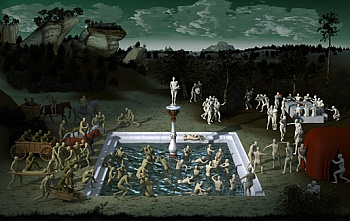 Miao Xiaochun has come back, down to earth. Back from the spheres of heaven, with figures floating in the detached and airy space that he so closely explored in his last large picture-series "The Last Judgement". And yet, it is not so much the firm and solid ground of earth that the Chinese photo-artist is interested in. He rather turns his attention towards an element which, at first sight, seems about as hard to grasp as the atmospheric range of the sky: water. However, the framework that he chose for his explorations (investigations) consistently remains the same: the array of Western art-history. He furthers his forays through the world of art and painting. And he leaves many enthralling hints for the observer, allowing him to follow.
Masterly in his use of digital visual media, Miao Xiaochun time and again lets u...
Miao Xiaochun has come back, down to earth. Back from the spheres of heaven, with figures floating in the detached and airy space that he so closely explored in his last large picture-series "The Last Judgement". And yet, it is not so much the firm and solid ground of earth that the Chinese photo-artist is interested in. He rather turns his attention towards an element which, at first sight, seems about as hard to grasp as the atmospheric range of the sky: water. However, the framework that he chose for his explorations (investigations) consistently remains the same: the array of Western art-history. He furthers his forays through the world of art and painting. And he leaves many enthralling hints for the observer, allowing him to follow.
Masterly in his use of digital visual media, Miao Xiaochun time and again lets u...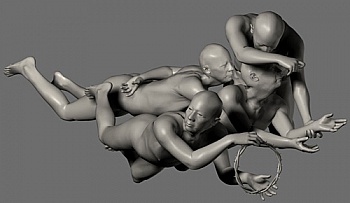 Wu Hung curates Beijing-based Miao Xiaochun's newest photography and video, which reexamine Michelangelo's "Last Judgment" using digital technology.
Miao Xiaochun has generated a 3-D model of his body and substituted his image for each of the 400 figures in Michelangelo's painting. Using software to manipulate the model into different positions, he then integrated these 3-D figures into a virtual space based on Michelangelo's composition. He could then travel within the painting like a tourist, taking photos as he went along, from within the pictorial frame as well as from without. The artist worked with three assistants for six months to create these works.
Wu Hung writes, "What do the figures in Michelangelo's Last Judgement - not only Christ and the Virgin but also the angels, the saints, the Damned, and the B...
Wu Hung curates Beijing-based Miao Xiaochun's newest photography and video, which reexamine Michelangelo's "Last Judgment" using digital technology.
Miao Xiaochun has generated a 3-D model of his body and substituted his image for each of the 400 figures in Michelangelo's painting. Using software to manipulate the model into different positions, he then integrated these 3-D figures into a virtual space based on Michelangelo's composition. He could then travel within the painting like a tourist, taking photos as he went along, from within the pictorial frame as well as from without. The artist worked with three assistants for six months to create these works.
Wu Hung writes, "What do the figures in Michelangelo's Last Judgement - not only Christ and the Virgin but also the angels, the saints, the Damned, and the B...